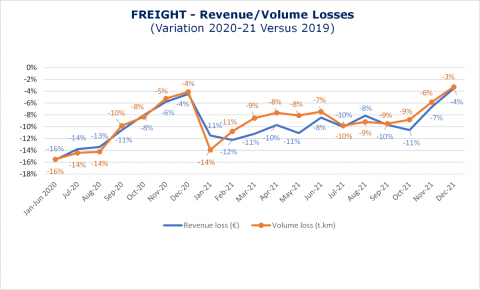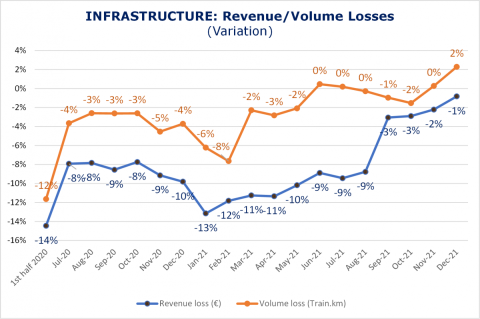COVID Impact Tracker: rail freight lost 4 billion in 2021 11/02/22
< Back to list
The 2021 results of the ‘CER COVID Impact Tracker’, carried out by the Community of European Railway and Infrastructure Companies (CER) are in. COVID-related revenue losses of the rail sector in the European Union (EU27) over 2020-2021 amount to 50 billion euros. Of this amount, 23 billion euros was the figure of 2021.
Although these numbers leave little room for celebration, they also show that the industry is on its way to recovery. Moreover, the rail freight sector came out relatively well, and is almost back to normal levels.
Rail freight loses 4 billion euros
All in all, no less than 33 per cent of turnover was lost over the past 2 years because of COVID. For rail freight, this translated into almost 4 billion euros in losses on freight services (-12 per cent in 2020 and -10 per cent in 2021). The rail passenger market was hit much harder. It faced more than 46 billion in losses on passenger services (-41 per cent in 2020 and -36 per cent in 2021).
The year 2020 was worse than last year. The industry overall witnessed a revenue loss of around 27 billion euros in 2020, compared to around 23 billion euros for 2021. Although this difference seems small, both passenger and freight sectors were at a much better position in December 2021 than in December 2020.
Back to normal figures
After a collapse in January 2021, freight revenue losses stagnated at around -10 per cent (compared to 2019) until October 2021. As in 2020, an upswing appeared towards end 2021, with almost ‘back to normal’ figures.
In its last data request, CER managed to collect volume data along with revenue data for the whole period of the pandemic. In freight, volume and revenue variations highly correlate. Average volume losses are around -10 per cent (-12 per cent in 2020 / -9 per cent in 2021).

Passenger services
Passenger services suffered most with an extremely low ‘winter season’ (from November 2020 to April 2021) at about:
- -50% in revenues (€),
- -60% in volumes (p.km),
and with a relatively less bad ‘summer season’ (May 2021 to October 2021) at around - -25% in revenues (€),
- -30% in volumes (p.km).
The new winter season starts again with a downturn in November-December 2021, however less severe than in 2020 (December 2021: -28 per cent revenues / -35 per cent volumes).
Infrastructure
While passenger volumes (in p.km) and freight volumes (in t.km) have dropped, train volumes (in train-km) “seem” to have returned to normal. However, infrastructure revenues remain in the red and consistently lag behind volumes.
The figures also hide significant differences between countries, linked to insufficient compensation received for COVID-related reductions of Track Access Charges (TAC).
“If not addressed, insufficient compensation for TAC reductions and inadequate support to operations may jeopardise infrastructure managers’ maintenance capacity as well as the investment capability of all rail stakeholders in the medium and long term”, the CER stated.

Long-lasting effect
At the 17 May 2021 Rail Summit, Ursula von der Leyen stressed “how important it is that the rail sector emerges stronger from COVID-19, and that Europe needs rail as a sustainable mode of transport more than ever to achieve the European Green Deal goals”.
CER Executive Director Alberto Mazzola said: “The COVID crisis continued to have a heavy impact on railways last year. In 2021, commercial revenues were down by 33% versus 2019. At the end of 2021, CER members resumed the same number of trains as in 2019, but with a reduced ridership (down by 35%). This shows that CER members continued to provide services in 2020 and 2021 proving the resilience of the rail system, keeping people and goods on the move across Europe. However, the amount of rail revenue losses in EU27 reached the alarming level of €50 billion. Left uncorrected, this will have a long-lasting effect.”





